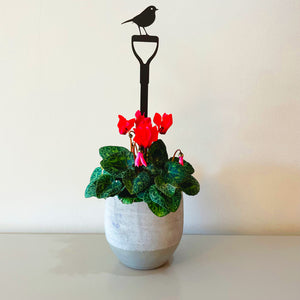{"id":7664722018552,"title":"Key Hooks - Wren","handle":"copy-of-key-hooks-wren","description":"\u003cmeta charset=\"utf-8\"\u003e\u003cmeta charset=\"utf-8\"\u003e\n\u003cp\u003eWrens are a family of brown passerine birds in the predominantly New World family Troglodytidae. \u003cbr data-mce-fragment=\"1\"\u003e\u003cbr data-mce-fragment=\"1\"\u003eThe English name \"wren\" derives from Middle English: wrenne and Old English: wrænna, attested (as wernnaa) very early, in an eighth-century gloss. It is cognate to Old High German: wrendo, wrendilo, and Icelandic: rindill (the latter two including an additional diminutive -ilan suffix). The Icelandic name is attested in Old Icelandic (Eddaic) as rindilþvari. This points to a Common Germanic name wrandjan-, but the further etymology of the name is unknown.\u003cbr data-mce-fragment=\"1\"\u003e\u003cbr data-mce-fragment=\"1\"\u003eThe wren was also known as the kuningilin ('kinglet') in Old High German, a name associated with the fable of the election of the \"king of birds\". The bird that could fly to the highest altitude would be made king. The eagle outflew all other birds, but he was beaten by a small bird that had hidden in his plumage. This fable was already known to Aristotle (Historia Animalium 9.11) and Pliny (Natural History 10.95), and was taken up by medieval authors such as Johann Geiler von Kaisersberg, but it most likely originally concerned kinglets (Regulus) and was apparently motivated by the yellow \"crown\" sported by these birds (a point noted already by Ludwig Uhland). The confusion stemmed in part from the similarity and consequent interchangeability of the Ancient Greek words for the wren (βασιλεύς basileus, 'king') and the crest (βασιλισκος basiliskos, 'kinglet'),and the legend's reference to the \"smallest of birds\" becoming king likely led the title to be transferred to the equally tiny wren. In modern German, the name of the bird is Zaunkönig ('king of the fence (or hedge)') and in Dutch, the name is winterkoning ('king of winter').\u003cbr data-mce-fragment=\"1\"\u003e\u003cbr data-mce-fragment=\"1\"\u003eThe family name Troglodytidae is derived from troglodyte, which means 'cave-dweller'. Wrens get their scientific name from the tendency of some species to forage in dark crevices.\u003c\/p\u003e\n\u003cp\u003ePart of a range of different key hook designs. Each comes with two holes for fixings to a wall. Screws not supplied. \u003c\/p\u003e\n\u003cp\u003eAll dimensions approximate. Illustrations for guidance on main design only. Actual hooks vary in length when bent by hand. Please also note that sometimes the design goes from left to right and vice versa - as we do all this in our studio and we like mixing it up!\u003c\/p\u003e\n\u003cp\u003eSizes:\u003cbr\u003eWren = 148 x 101 x 0.9 mm\u003cbr\u003e\u003c\/p\u003e\n\u003cp\u003eMaterial: Zinc-coated mild steel, powder coated\u003c\/p\u003e","published_at":"2022-04-14T13:46:34+01:00","created_at":"2022-04-14T11:07:29+01:00","vendor":"A Blackbird Sang","type":"Keyhook","tags":["Bird","Birds","Birds of the UK","Faire","Functional","Hook","Hooks","key hook","Keyhook","NT","NT Online","Retail","Typography","Wren","XBLD"],"price":1395,"price_min":1395,"price_max":1395,"available":true,"price_varies":false,"compare_at_price":1295,"compare_at_price_min":1295,"compare_at_price_max":1295,"compare_at_price_varies":false,"variants":[{"id":42735319023864,"title":"Wren","option1":"Wren","option2":null,"option3":null,"sku":"KEYH05","requires_shipping":true,"taxable":true,"featured_image":{"id":37148654895352,"product_id":7664722018552,"position":1,"created_at":"2022-04-14T11:07:31+01:00","updated_at":"2022-04-14T11:07:31+01:00","alt":null,"width":1024,"height":1024,"src":"\/\/ablackbirdsang.com\/cdn\/shop\/products\/abs_keyhooks_wren_1024px_e90cfb8d-5c17-42ff-9007-806cbe9059a7.jpg?v=1649930851","variant_ids":[42735319023864]},"available":true,"name":"Key Hooks - Wren - Wren","public_title":"Wren","options":["Wren"],"price":1395,"weight":75,"compare_at_price":1295,"inventory_quantity":36,"inventory_management":"shopify","inventory_policy":"deny","barcode":"5060925561630","featured_media":{"alt":null,"id":29715141034232,"position":1,"preview_image":{"aspect_ratio":1.0,"height":1024,"width":1024,"src":"\/\/ablackbirdsang.com\/cdn\/shop\/products\/abs_keyhooks_wren_1024px_e90cfb8d-5c17-42ff-9007-806cbe9059a7.jpg?v=1649930851"}},"requires_selling_plan":false,"selling_plan_allocations":[]}],"images":["\/\/ablackbirdsang.com\/cdn\/shop\/products\/abs_keyhooks_wren_1024px_e90cfb8d-5c17-42ff-9007-806cbe9059a7.jpg?v=1649930851"],"featured_image":"\/\/ablackbirdsang.com\/cdn\/shop\/products\/abs_keyhooks_wren_1024px_e90cfb8d-5c17-42ff-9007-806cbe9059a7.jpg?v=1649930851","options":["Design"],"media":[{"alt":null,"id":29715141034232,"position":1,"preview_image":{"aspect_ratio":1.0,"height":1024,"width":1024,"src":"\/\/ablackbirdsang.com\/cdn\/shop\/products\/abs_keyhooks_wren_1024px_e90cfb8d-5c17-42ff-9007-806cbe9059a7.jpg?v=1649930851"},"aspect_ratio":1.0,"height":1024,"media_type":"image","src":"\/\/ablackbirdsang.com\/cdn\/shop\/products\/abs_keyhooks_wren_1024px_e90cfb8d-5c17-42ff-9007-806cbe9059a7.jpg?v=1649930851","width":1024}],"requires_selling_plan":false,"selling_plan_groups":[],"content":"\u003cmeta charset=\"utf-8\"\u003e\u003cmeta charset=\"utf-8\"\u003e\n\u003cp\u003eWrens are a family of brown passerine birds in the predominantly New World family Troglodytidae. \u003cbr data-mce-fragment=\"1\"\u003e\u003cbr data-mce-fragment=\"1\"\u003eThe English name \"wren\" derives from Middle English: wrenne and Old English: wrænna, attested (as wernnaa) very early, in an eighth-century gloss. It is cognate to Old High German: wrendo, wrendilo, and Icelandic: rindill (the latter two including an additional diminutive -ilan suffix). The Icelandic name is attested in Old Icelandic (Eddaic) as rindilþvari. This points to a Common Germanic name wrandjan-, but the further etymology of the name is unknown.\u003cbr data-mce-fragment=\"1\"\u003e\u003cbr data-mce-fragment=\"1\"\u003eThe wren was also known as the kuningilin ('kinglet') in Old High German, a name associated with the fable of the election of the \"king of birds\". The bird that could fly to the highest altitude would be made king. The eagle outflew all other birds, but he was beaten by a small bird that had hidden in his plumage. This fable was already known to Aristotle (Historia Animalium 9.11) and Pliny (Natural History 10.95), and was taken up by medieval authors such as Johann Geiler von Kaisersberg, but it most likely originally concerned kinglets (Regulus) and was apparently motivated by the yellow \"crown\" sported by these birds (a point noted already by Ludwig Uhland). The confusion stemmed in part from the similarity and consequent interchangeability of the Ancient Greek words for the wren (βασιλεύς basileus, 'king') and the crest (βασιλισκος basiliskos, 'kinglet'),and the legend's reference to the \"smallest of birds\" becoming king likely led the title to be transferred to the equally tiny wren. In modern German, the name of the bird is Zaunkönig ('king of the fence (or hedge)') and in Dutch, the name is winterkoning ('king of winter').\u003cbr data-mce-fragment=\"1\"\u003e\u003cbr data-mce-fragment=\"1\"\u003eThe family name Troglodytidae is derived from troglodyte, which means 'cave-dweller'. Wrens get their scientific name from the tendency of some species to forage in dark crevices.\u003c\/p\u003e\n\u003cp\u003ePart of a range of different key hook designs. Each comes with two holes for fixings to a wall. Screws not supplied. \u003c\/p\u003e\n\u003cp\u003eAll dimensions approximate. Illustrations for guidance on main design only. Actual hooks vary in length when bent by hand. Please also note that sometimes the design goes from left to right and vice versa - as we do all this in our studio and we like mixing it up!\u003c\/p\u003e\n\u003cp\u003eSizes:\u003cbr\u003eWren = 148 x 101 x 0.9 mm\u003cbr\u003e\u003c\/p\u003e\n\u003cp\u003eMaterial: Zinc-coated mild steel, powder coated\u003c\/p\u003e"}











